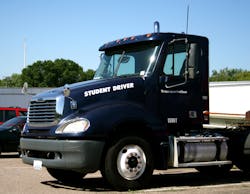It took nearly a decade for regulators to revise and enact new truck driver training rules, which finally went into effect this week. While those new rules focus on driver curriculum, some recent mainstream media centered on the training rules’ “lack of standards,” creating unsafe learning situations for new drivers, particularly women.
Time magazine declared this week that the trucking industry has a driver training problem causing more highway fatalities, high commercial driver turnover rates, and sexual assault and harassment of female drivers. Trucking industry leaders and trainers who FleetOwner spoke with noted how the mainstream media doesn’t understand how vital roadway safety is to most fleets.
On Feb. 7, Time released a scathing report criticizing the trucking industry’s revised Entry-Level Driver Training rules, which have been in the works for nearly seven years and coincidentally took effect on Feb. 7. These rules aim to tighten how truck driving schools teach and train new drivers. But provisions requiring minimum hours of behind-the-wheel driving time did not make their way into the new ELDT requirements—a point of contention among some industry groups, such as the Owner-Operator Independent Drivers Association.
“We mainly think that the standards that went into effect this week don’t go far enough,” an OOIDA spokesperson told FleetOwner. “There are no behind-the-wheel minimum hours and trainers are allowed to self-certify.”
Ellen Voie, president and CEO of the Women in Trucking Association, served on the 25-member ELDT Advisory Committee. When the committee concluded, she said a minimum-hours requirement was included. However, when the rule was sent to the federal Office of Management and Budget, the hours' requirement was removed.
“The explanation given concerned industry costs associated with the hours,” Voie told FleetOwner. “I have a private pilot’s license and was required to have 40 hours of flying time before I could take my check ride, where I had to demonstrate proficiency. I can’t understand why the 30 minimum hours were removed.”
Regardless, Voie said Time’s portrayal of the industry was not fair, calling it “pointed” despite the trucking industry’s long history of focusing on safety.
“It makes people think that we are not that concerned about safety, which is the top priority for everyone,” she said. “This industry is striving to be a safe industry for everyone, whether it’s personal safety, safety of equipment, and safety for everyone on the road, and the public isn’t getting that perception.”
Voie added that the mainstream media, such as Time, tend to magnify negative news related to trucking. “No matter what we do in the trucking industry, it just doesn’t seem to overcome that negative coverage,” she said.
Real-world training is key
WorkHound, whose platform gathers driver feedback for trucking fleets, just released its data analysis for 2021. Nearly 50% of drivers who communicated their concerns about training and orientation left their companies.
“When it comes to new drivers entering the industry, if you talk to any company, turnover is the highest in the first 90 or 180 days,” Max Farrell, WorkHound co-founder and CEO, told FleetOwner. “Some of that is determining if the industry is a fit for that person, and some of it is someone determining if a company is a fit.”
Based on WorkHound’s latest feedback, Farrell acknowledged that there is room for improvement in how companies approach training.
When dissecting driver feedback satisfaction scores, training comments that are combined with pay and communication have lower satisfaction ratings, according to WorkHound.
“Those are themes that are worth paying attention to,” Farrell said. “Whenever we receive feedback about pay, often it’s people not understanding their pay or feeling like their pay is incorrect. I would argue that pay is more often a communication challenge than an amount challenge."
One of the best things that companies can do for their drivers, Farrell noted, is make a commitment to simplify their pay structures.
Voie pointed out that when she went through CDL training, she had a positive experience that included some 180 hours of training behind the wheel.
“I had excellent training,” Voie said. “The schools train you on the basics, but then the carriers really have to give you that added knowledge, and that’s why drivers go out for two to five weeks at a time. The industry is doing everything possible within the regulations to give drivers a good experience.”
The new ELDT rule means everyone looking to obtain their CDL will be using the same curriculum nationwide, with prospective drivers required to pass a theory/knowledge test and a road skills test. First mandated by Congress in 2012, the Entry-Level Driver Training Advisory Committee created the regulations through a negotiated rulemaking process in 2015. It finally worked its way into federal law this month—a decade after first being mandated.
David Heller, Truckload Carriers Association VP of governmental affairs, who also helped draft the rule, explained that the new regulation is designed to measure competency for new drivers operating a commercial vehicle that can weigh up to 80,000 lb.
“It’s interesting, [Time] talks about the lack of hours behind the wheel, but I think it’s fair to note that a prescription of hours behind the wheel time does not guarantee a safe driver, either,” Heller told FleetOwner on Feb. 8. “You could put a person behind the wheel for a certain number of hours to practice things that they need to practice, but that doesn’t necessarily mean they are going to be great at it."
“If you’re getting on an airplane, do you want a pilot that has achieved a prescribed number of hours of training, or do you want a pilot that has demonstrated enough competency to operate the airplane,” Heller added.
When asked if trucking needs a training overhaul, Heller said not all training needs it. What is needed, he said, is a minimum standard.
“That’s what we have now; we have a minimum standard that prescribes curriculum for students to train to—which never previously existed, and allowed for what we call in the industry, ‘CDL mills,’” Heller said. “Basically, it would be a truck driving school that would [hypothetically] say, ‘We’ll get your drivers trained in 48 hours.’ That’s not the right way to train the driver.”
The right way to train a driver, Heller advised, is making sure the driver has a thorough understanding of how to operate a commercial truck.
“I certainly think this was a one-sided article that should have erred on the side of trucking because there are some very good schools out there that operate in a public environment, that operate in a private environment, and there are also some schools that carriers run and own to train truck drivers that are highly successful and certainly safely train drivers as they enter the industry,” Heller said.
OOIDA, which was quoted by Time, said it hopes the article will “highlight the need to make improvements to the industry so that it can be a lifelong career as opposed to the continued high turnover of drivers.”
Sexual harassment and training
The second half of the Time article contends that long-haul truck driver training has turned into a “profit center” and led to an increase in sexual harassment, assault, and rape of female drivers.
Time isolates one carrier, CRST, and points to $17 million in settlements over previous lawsuits filed against it for wage theft, sexual harassment, and assault incidents that occurred while training people who wanted to become truckers.
Phil Reges, CRST’s VP of operations, told FleetOwner on Feb. 8 that every employee and driver who comes to the company participates in a positive work environment training, which includes sexual harassment training.
When asked about the allegations made in the Time article, Reges said: “It unfortunately paints a bad picture, and it’s not who we are.”
Unrelated to the allegations against CRST, Reges said the company has built out more communications within its operations to generate increased feedback from drivers. CRST, Reges noted, is also working to continuously train and educate drivers, improve safety, and upgrade fleet equipment.
As far as training goes in the industry, WIT is a strong advocate for a same-gender training option for any female (or male) trainee who feels more comfortable with a trainer of the same gender.
“We’re the only industry that mixes genders in a training environment with sleeping arrangements where they are expected to share an enclosed space,” Voie said. “I had a driver contact me last week. She finished her truck driving school, and she went to a company and asked for a female trainer. They said they didn’t have any available, so she said she would pay for her own hotel room, and they said 'no.' So, she left and went to a different company.”
That driver, Voie said, ended up going to Schneider, which puts driver trainees in separate hotel rooms during over-the-road training.
“Carriers should put someone in a hotel. To me, that’s a best practice,” Voie said.
Based on a recently released whitepaper on same-gender training, WIT surveyed 416 female drivers and asked them about sexual harassment in the industry.
“It’s pretty prevalent,” Voie said, noting that 42.5% of survey respondents said yes. “It was shocking how many women experienced or knew of someone who experienced sexual harassment or assault when sharing the cab with a male trainer.”
When asked whether WorkHound ever sees sexual harassment feedback come through, Farrell acknowledged that it has.
“It’s heartbreaking when it does,” Farrell said. “That being said, the companies we work with are quick to act on it, and oftentimes that has been the key way that they find out about this really challenging situation so they can do something about it.”
Farrell recalled feedback from a few years ago when a driver trainee shared feedback that they didn’t feel safe.
“The company was able to connect with the driver and address the issue,” Farrell said. “We are grateful that people can have a voice to express those sorts of things. We hate that it happens, but I would much rather have someone have the opportunity to share and get the issue addressed than suffer in silence. That’s the last thing any of us want.”
Josh Fisher contributed to this article.







